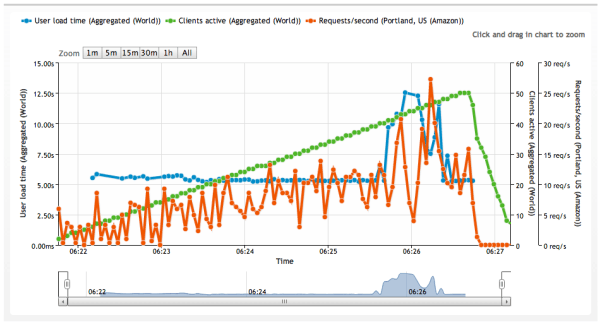Building up my Testimonials Area
The other day I asked a few folks to share with me some quotes that would soon show up on my site (as I work on a design overhaul). These quotes would be part of my testimonial section of the site. Lucy Beer, of Web Training Wheels, sent me a quote and I sent my favorite photographer, Raquel Landefeld (CodyL is her husband), out her way to get her photo.
I wasn't yet sure how I would use them, and then I thought…should I? Could I? What if I put all the quotes and photos into a slider.
And that led me to think about comparing the new WooSlider (v2) against Soliloquy, in terms of performance. I'd promised to do it and had yet to. So it felt like a good time to try.
Some Background Info
You may not recall but I've tested a whole bunch of sliders before, comparing their performance. If you read the comments, people ask about this particular comparison for a year!
In that comparison (a year ago), there was a clear winner: Soliloquy. It made less calls, loaded faster and was really easy to use. But how would it do a year later? I was about to find out.
But let me highlight how the test was done first.
- I spun up a fresh install of WordPress on my host, WP Engine.
- I activated Akismet, and then only loaded the two slider plugins.
- I uploaded 15 large images, we're talking about 5000 by 3000 pixels.
- I readied pingdom tools & loadimpact to test performance.
- Each test only had one of the two plugins activated.
Comparing Price
Now, this is a performance test, not a price comparison. But, you're paying for this level of performance, from either one, so it's worth telling you a little something about each price. In this case, Soliloquy wins – priced at $19 for a single site license, whereas WooSlider costs $49 for a single license.
Comparing Ease of Use
Again, the best performing slider is only worth it if you can use it. And I'll be honest, there was a reason why WooSlider wasn't in the first batch of tests. I couldn't figure out how to make it do something really simple. And since I couldn't use it, I couldn't compare it. And I didn't know if it was user error (likely), or plugin design.
But this time, WooSlider was much easier to use. I don't know if I got smarter in a year, but the interface let me do what I wanted in no time flight. As for Soliloquy, it's always been really simple to use, so I wasn't worried that it suddenly had gotten more difficult.
Between the two, it was a tie.
Slider Performance under Load
I started by using LoadImpact to simulate 50 concurrent users hitting my server, requesting my page, which held a slider of 15 images. The slider was 800 pixels wide (even though the images uploaded were over 5000 pixels wide). As you recall, I did this last time too – using images that were larger and then creating a smaller slider. I do this because I want to know if the plugin will do something to my images or not.
Soliloquy
If you look at the test results for Soliloquy, you'll see that for the longest part of the test (until hitting about 40 concurrent users), performance was stable. Now when you look at the load time, it's not talking about time to first byte. It's looking at loading the whole page. And we're talking about 15 images that “weighed” 33 MB. So the 5 second page load made sense to me. But the user experience is much faster, because Soliloquy starts displaying slides right away.
As the load pushes past 40 concurrent users, you'll notice things go a bit crazy. Now to put this into perspective, this is 40 simultaneous and concurrent users hitting the page. In real world terms, that's like talking about tens or hundreds of thousands of pageviews in a day. So most of us will never have that problem.
WooSlider
Now when I saw these results, I was shocked. Sure things were more volatile, but look at the user load time – it hovers around 2 seconds! It was handling a lot more requests per second as well. What kind of magic is going on here?
Under load, the winner was WooSlider.
Digging Deeper with Pingdom Tools
At this point, I had to see what WooSlider had done to do so well. So I again got ready to test, only this time, I used Pingdom tools – a different kind of test that let me look at the details.
What I found was surprising, to say the least.
Apples and Oranges
When I looked at Soliloquy under the microscope, I found that it had gotten better – making 28 requests instead of 31 (a year ago). That clearly helped because it loaded in 535 milliseconds – while loading a 31 MB page. Now, I know, I could have sized my images smaller for the test. I get that. But like I said before, I did it on purpose.
Now think about that – 31 MB of images, with a load time of half a second. That's what makes Soliloquy rock!
Looking at WooSlider, I saw something completely different. It loaded in 778 milliseconds (a tiny bit slower), but the page load was 1.5 MB.
Did you catch that?
As I looked closer, I found the difference – and it explained a lot. WooSlider was using my image thumbnails (at 600 pixels wide) instead of the full images. And that meant it was loading a lot less data to present the 800 pixel slider.
Now, if we were comparing sliders of images at 600 each, I'm sure I'd see something different – in both tests.
But this highlights the whole reason I had loaded large images. Some sliders compress images, others use smaller versions. Clearly WooSlider used my large thumbnails – and it was difficult to notice the difference.
So who wins?
Well, in terms of an apples to apples comparison, I would venture to say Soliloquy still takes the top spot. After all, it beat the single test in performance even while loading 30x more files. But WooSlider does a fantastic job under load – especially if you haven't taken the time to adjust your large images before uploading them. Because it will do it for you.
In the end, I'm pretty sure I can say with 100% assurance, that the winner is you. It's me. It's everyone who uses either of these slider plugins, because clearly they're focused on performance.



